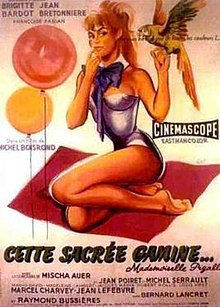|
Naughty Girl (film)
Naughty Girl (French: Cette sacrée gamine), also released as Mam'zelle Pigalle, is a 1956 French CinemaScope musical film starring Brigitte Bardot. PlotHandsome cabaret entertainer Jean Clery is engaged to his psychiatrist, Lili. He sings at a nightclub owned by Paul Latour which is being used as a front for a gang of forgers. Paul has been framed and decides to go to Switzerland to find out who is really behind this. He has a daughter, Brigitte, who is at finishing school and thinks he is a shipbuilder. Paul asks Jean to retrieve Brigitte from school and look after her for a few days so she is not caught up in the police investigation. Jean collects Brigitte pretending to be her uncle and keeps her at his apartment. While there, Brigitte causes chaos, upsetting Jean's butler, starting a fire, getting arrested for swearing and winding up in prison, and causing troubles with Jean's engagement to Lili. Eventually Brigitte and Jean fall in love and the real crooks are caught. Cast
ProductionAccording to Roger Vadim, producer Mr Senaumd had mostly made B movies. The producer had heard of a successful last minute rewrite Vadim did on Julietta and asked Vadim to perform a similar function on this film, which had been sold to Italy, but whose script star Jean Bretonniere did not like. Vadim agreed provided his then-wife Brigitte Bardot was cast as the female lead and if Michel Boisrond, René Clair's first assistant director, would direct. Vadim later wrote "for the first time, Brigitte played a character written for her, in modern language; and she had a classically trained director who was making his first film." He called the movie "a French equivalent of a Doris Day movie but with a bolder, more liberated edge."[2] ReceptionBox officeThe film was a box-office hit in France, being the 12th most popular movie of the year. It was slightly more popular than And God Created Woman which Vadim directed later that year.[3] CriticalThe Observer wrote that the director "has learnt the knack of raising a simple laugh, not yet the art of touching heart and mind."[4] The Los Angeles Times praised the "tight, high speed direction."[5] The New York Times wrote that the film:
References
External links |
||||||||||||||||||||||||||
